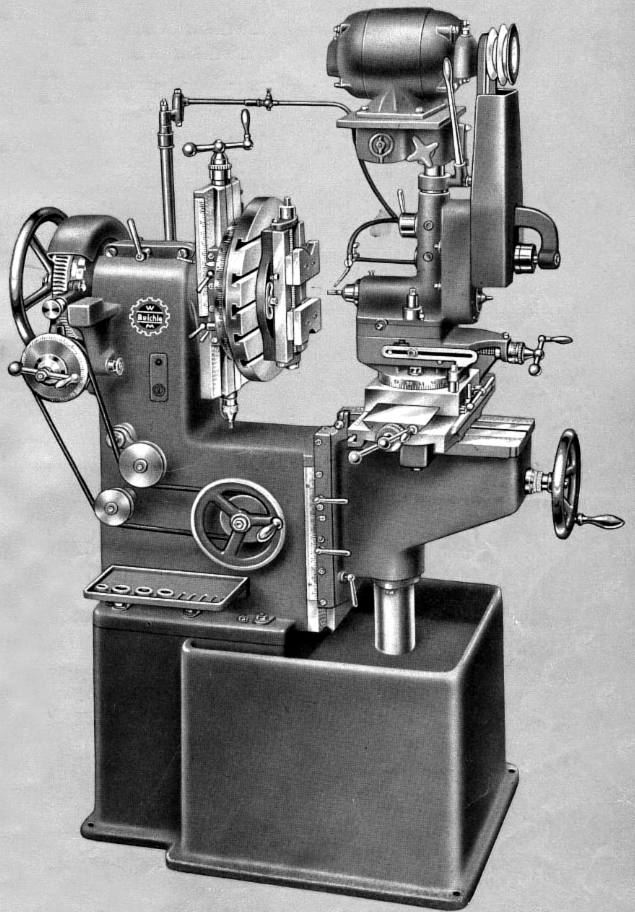|
Manufactured by Herman Beichle of Heidenheim-Schnaitheim, in Germany, the massively-built Combined Universal Die Milling Machine was marketed in Britain during the 1930s branded as Excel - a name also used on a variety of other high-quality machine tools including a copy of the tiny bench-top Leinen jig borer. Although at first only one size was offered, after WW2 (though other agents in the UK) three sizes were listed: W.F.1, W.F.2 and W.F.3. The machine was specifically designed to both facilitate work on smaller, complex moulds and dies while also providing an easier and quicker means of holding and machining awkwardly-shaped components to a high degree of accuracy - and without the need to constantly remount and mark-off work.
Although they could not be moved out of their horizontal planes, the machine was otherwise designed so that the cutter head and workpiece could be arranged relative to each other in as great a variety of ways as possible. The right-hand side of the machine was formed as a horizontal table with two longitudinal T-slots; mounted on the table was a slide, with 11.5" of travel, and on top of that another swiveling 31/8"-travel slide formed so that it provided a housing for the bearings of the cutter head. When its retaining T-bolts were loosened, the whole of the compound slide assembly could be moved towards or away from the workhead through a distance of 61/4"
The left-hand side of the miller was bored through to carry a solid steel bar that carried, on its inner face, a T-slotted, 43/4"-travel slide rest and, on its outer, both a direct-acting, 24-notch indexing circle and a worn gear. Thus, the assembly could be quickly indexed to any factor of 24, or fed round steadily through 360 degrees by a handwheel (on the front face of the miller) connected to the worm-and-wheel mechanism by a round-rope drive; a gap in the casting, immediately in front of the slide, allowed the feed-screw handle room to turn. Unfortunately, the opportunity was not taken to fit direct gearing, with a proper scale, and so allow the worm-and-wheel drive to create the function of a rotary table.
The standard-fit swiveling and self-centering vice had a capacity of 51/4" and each hardened and reversible jaw (with a flat on one side and V on the other) had a removable top section that could be replaced quickly by a "special" made up in the toolroom Although this was a useful method of work holding, in order to make the most of the machine's quick-setting abilities an optional "universal" swiveling, tilting and rocking vice was available; this had only 2-inch wide jaws, and a reduced capacity of 33/4", but the swivel base could be indexed and pinned by a taper pin at 15-degree intervals. All three linear slides were fitted with fine-feed screws, micrometer dials, engraved rulers, screw stops and powerful twin locking screws.
Using a 1/2 hp 1400 rpm motor, the drive was via a round "rope" over adjustable and swiveling jockey pulleys that allowed the belt to meet the milling head at the correct angle no matter what its angular position. For milling work four speeds were provided of 700, 1000, 1400 and 1900 rpm; if used for milling, grinding or drilling with very small diameter tools alternative pulleys could be provided that allowed a maximum speed of just over 5000 rpm to be reached.
Besides the swiveling vice, standard equipment supplied with the machine included: five collets to hold cutters with shank diameters of 5/32", 1/4", 5/16", 3/8" and 1/2"; a 3-jaw chuck with a degree-graduated backplate and index pin, a cast-iron floor stand with a small coolant pan, coolant tank and a storage cupboard; a motor bracket and tool tray, a 7/16" arbor to mount cutter and a set of spanners. The short options list ran to a light unit, a magnifying glass in a ball-jointed holder and the previously-described universal vice.
Complete on its stand the machine weighed approximately 640 lbs..
|
|


